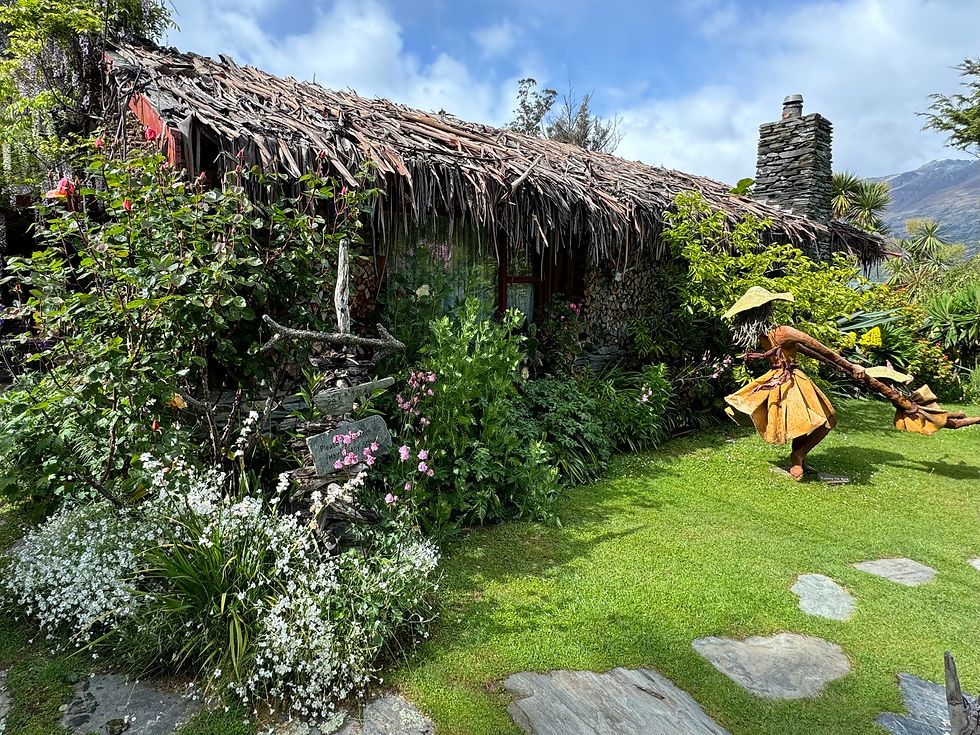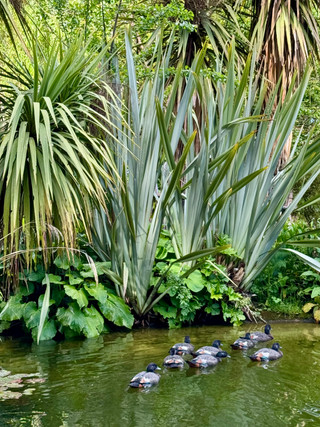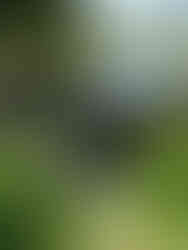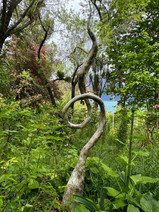MY LIFE WITH PLANTS - New Zealand, The Wild Dream Garden
- Jim Bishop
- Jan 1
- 4 min read
Words and pictures by Jim Bishop, for Let's Talk Plants! January 2025

This November, my partner Scott and I spent 14 days with the Oregon Hardy Plant Society touring the gardens of New Zealand's South Island. We saw some incredible places and gardens, so many that it was nearly impossible to choose which ones to mention here. Initially, I intended to write about The Giant’s Garden with its stunning mosaics, which was also one of the reasons I wanted to join the tour.

Reflecting on the numerous gardens we toured, I chose to focus on the natural creativity of the final garden we saw, The Wild Dream Garden, situated on the shores of Lake Wakatipu along Glenorchy-Queensland Road, directly on the 45th south parallel.

The garden is the result of over two decades of work by folk art artist and gardener Thomas Schneider, originally from Switzerland. In Switzerland, he worked as a forest ranger. Thirty-nine years ago, during a year-long trip initially planned for Australia, he made a stop in New Zealand on his way. Upon reaching Australia, he found the dryness unappealing and returned to New Zealand, eventually settling there permanently. His passion for nature is evident in his diverse garden, where he has crafted a wonderland of paths, ponds, views, whimsical statues, folk art, birds, and snippets of philosophy. Join me for a stroll through the garden.


The sign reads:
Little Paradise
Take a break and enjoy the peace of our 5 acre fairy tail garden.
Discover creative work and inspiring nature compositons while listering to singing frogs birds and the sound of water.
Read the time on the sundial
fountain and try to copy some of the positions of the yoga statues. Follow the smell of the 3000 roses on the 700 meter windy trails and
explore the unusual variety of
flowers along the way.





















One of many yoga post statues in the garden. This one spans a small stream.


Moas and Maoris


MOA, flightless Birds:
There were eleven different species of Moa living in New Zealand. The smallest was the size of a Turkey, 50 - 80cm in height up to the two biggest species with the height of 3.7m and 250 kg in weight. The male was smaller than the female and most likely he was sitting on the nest. The Haast Eagle was the only predator until the humans arrived in this country.
Most of the Moa species died out around 500 years ago because of human activities such as over hunting, plundering the eggs and burning large areas of bush land. Maori hunters claimed to hunt Moas until 1770s. Some Moa bones had been found dated 2 million years back.
Haast's Eagle:
Maori name: Te Hokioi, Te Pouakai
New Zealand had the world's largest Eagle and the most feared predator in the land with a wingspan up to 3m and approximately 13- 18 kg in weight.
He was mainly feeding on the Moa and some other large birds. Apparently, also humans became part of his menu. With the extinction of the Moa, the Eagles main food source was gone. Most likely as a result of the food shortage, the Eagles became extinct around the same time as the Moas, 500 years ago.
Eagle bones aged from 500 to 30,000 years oid have been found, only in the South Island.

Strike a Pose
More yoga pose statues:

< Click on the images for a larger view. >
The biggest Freshwater Eels
They live in New Zealand and the Islands in the South Pacific and can each a length of 3 meters.
Some farmers blamed a big eel when they lost a dog on a river crossing.
Don't bother to convince your Partner for a swim, it won't work.
The 3-meter monster is here is well fed.
Many of the streams and lakes in New Zealand have been stocked with non-native fish species.
Showing his forestry background, Thomas recommends planting a tree when someone dies.
Thomas also built a display showing a family planting a tree when a new baby is born.
Peacocks Strutted and Called in the Upper garden



Gates and Arches
There were a lot of gates and passageways in the garden. Here are a few:
And one of my favorites, another moon gate on the 45th South Parallel:


The bathroom included a fish tank.
The House
The house was filled with artwork and furniture that were inspired by nature and crafted from local materials.
Garden hardscape and points of interest:
And because this is a garden, here's some flowers and plants:
















































































































































